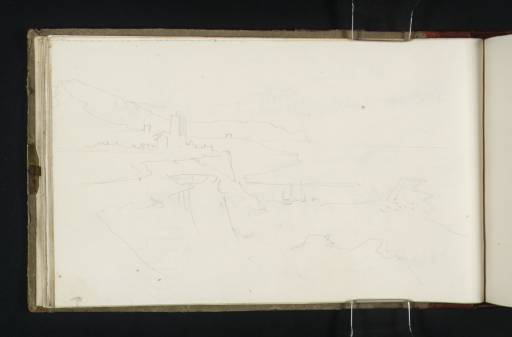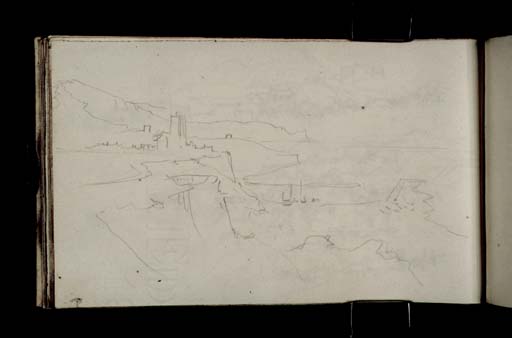Joseph Mallord William Turner Folkestone Church and Harbour c.1821-2
Image 1 of 2
Joseph Mallord William Turner,
Folkestone Church and Harbour
c.1821-2
Joseph Mallord William Turner 1775–1851
Folio 17 Verso:
Folkestone Church and Harbour c.1821–2
D17235
Turner Bequest CXCVIII 17a
Turner Bequest CXCVIII 17a
Pencil on white wove paper, 113 x 187 mm
Partial watermark ‘T Ed | 18’
Partial watermark ‘T Ed | 18’
Accepted by the nation as part of the Turner Bequest 1856
References
1909
A.J. Finberg, A Complete Inventory of the Drawings of the Turner Bequest, London 1909, vol.I, p.604, CXCVIII 17a, as ‘Folkestone Church and Harbour. See Water Colour engraved in “Southern Coast” & published 24 February, 1826.)’.
1999
Ian Warrell, Turner on the Seine, exhibition catalogue, Tate Gallery, London 1999, pp.96, 256 note 7.
As observed by Finberg, here Turner renders the church of St Mary and St Eanswythe in its position above the port at Folkestone, with cliffs stretching off in the direction of Dover in the background.1 Vessels are docked in the harbour, their masts breaking the placid stretch of flat water towards the shore. Two Martello towers crown the hillsides on either side of the church. For a brief outline of the history and purpose of these towers, and a list of the pages in this sketchbook which describe them, see the entry for folio 5 verso (D17215).
Finberg has been supported by later scholars in his description of this page as a primary source for Folkestone, Kent, painted in about 1823 (Taft Museum of Art, Cincinnati, Ohio ),2 engraved by R. Wallis and published in 1826 for Picturesque Views on the Southern Coast of England series (Tate impression: T05997).3 He additionally cites a later drawing in this sketchbook on folio 24 verso (D17248) as inspiration for the same composition.4
Ian Warrell cites this page in his outline of one of Turner’s forays into topographic fantasy. Light-towers of la Hève; moonrise of about 1844 (Lady Lever Art Gallery, Port Sunlight)5 contains two embellishments. One of these appears to be the St Mary and Eanswythe church, dropped into the French scene on the left of the lighthouses.6 According to Warrell, the second incongruous addition is a church taken from a vignette of Margate.7 To use Warrell’s words: ‘[why] Turner decided to merge the Cap de la Hève with places on the Kent coast remains a mystery’.8 Whatever the reason, the presence of the Folkestone church in this scene demonstrates the enduring circulation of sketchbooks within Turner’s studio; acting as inspiration even for works to which they might seem irrelevant.
There are a great number of studies of Folkestone in the present sketchbook, a fact made evident by its title. These drawings can be found on folios 3 recto, 4 verso, 5 verso, 14 verso, 17 verso, 20 verso–21 verso, 24 verso, 25 recto, 27 verso–29 recto, 30 verso–32 recto, 33 verso, 34 recto, 37 verso, 38 recto, 52 verso, 82 recto, 87 recto, and 90 verso (D17211, D17213, D17215, D17230, D17235, D17240–D17242, D17248–D17249, D17252–D17255, D17258–D17261, D17263–D17264, D17270–D17271, D17293, D17347, D17355, D17362). For an overview of Folkestone’s role in Turner’s oeuvre more broadly, refer to the sketchbook Introduction.
Other examples of St Mary’s and St Eanswythe’s Church in the Folkestone sketchbook can be found specifically on folios 14 verso, 21 recto, 21 verso, 24 verso, 27 verso, 28 recto, and 28 verso (D17230, D17241–D17242, D17248, D17252–D17254).
See also Turner’s earlier view of the Lees and the church from the Stade in his Richmond Hill; Hastings to Margate sketchbook of about 1816–19 (Tate D10479; Turner Bequest CXL 36a); and the later Holland sketchbook of 1825 (Tate D18855, D18857, D18859, D18860, D19399; Turner Bequest CCXIV 8, CCXIV 9, CCXIV 10, CCXIV 10a, CCXIV 282).
Maud Whatley
January 2016
How to cite
Maud Whatley, ‘Folkestone Church and Harbour c.1821–2 by Joseph Mallord William Turner’, catalogue entry, January 2016, in David Blayney Brown (ed.), J.M.W. Turner: Sketchbooks, Drawings and Watercolours, Tate Research Publication, February 2017, https://www


